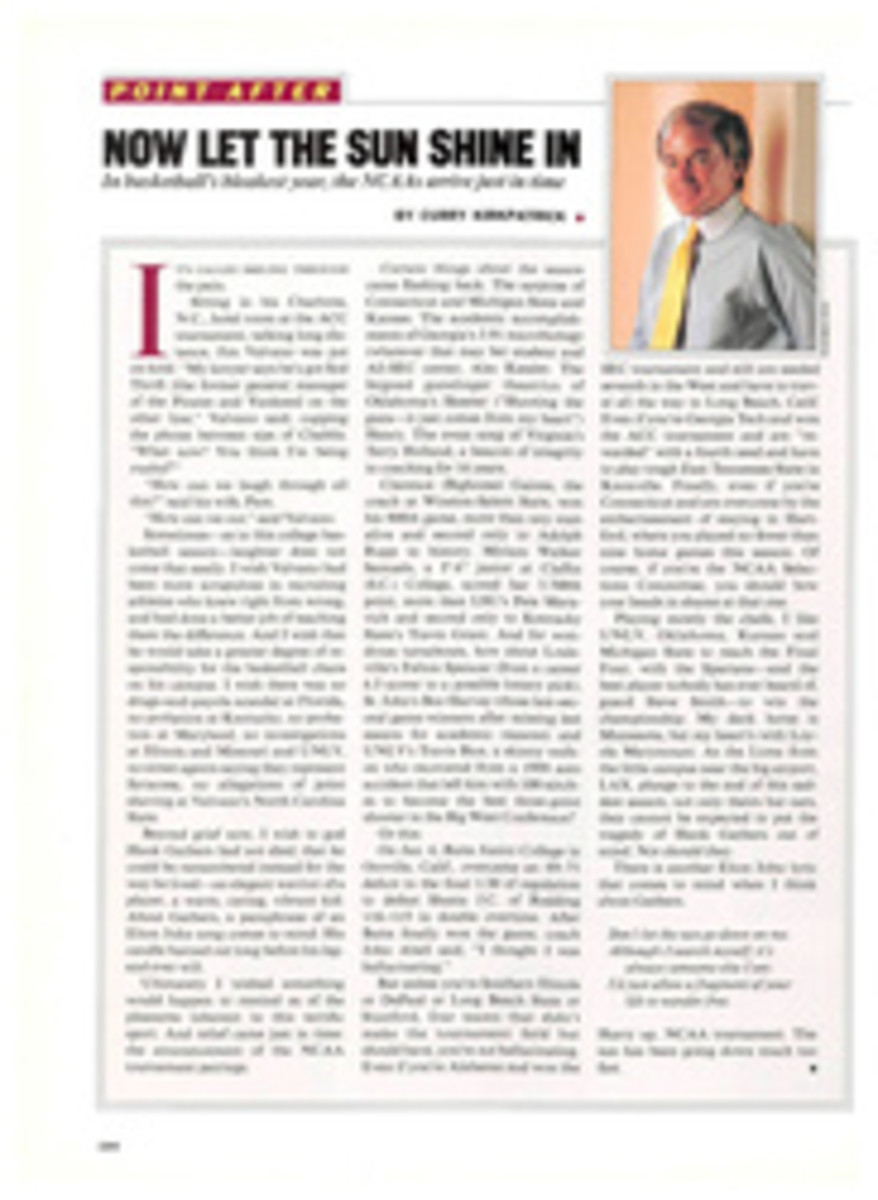
FIREWORKS IN FORMULA ONE
What a difference a year makes. Last June, when the Formula One crowd put its wares on display in the streets of Phoenix, in the inaugural running of the Iceberg U.S. Grand Prix, the race was won by Alain Prost, a diminutive Frenchman who was involved in a growing feud with his McLaren-Honda teammate, Ayrton Senna. On Sunday, in the second running of the race, Senna, a brilliant but difficult Brazilian driver, won the 1990 U.S. Grand Prix in a McLaren, beating, among others, Prost, now wheeling a Ferrari, to gain sweet revenge for a season of humiliation.
The spat that would soon develop into raging antipathy between Prost and Senna began in April 1989 at the San Marino Grand Prix, where Prost felt he was betrayed by Senna. It seems that at San Marino, Senna and Prost had agreed not to challenge each other on the first lap, in the interest of safety. But soon after the start. Senna, the '88 world champion, sucker-passed his teammate and went on to win the race.
Senna also won the next two races (Monaco and Mexico) before the Grand Prix circuit went to Phoenix last June, where Senna experienced car trouble and Prost scored his first win of '89. But Senna had been the fastest qualifier at Phoenix and by then Prost was convinced that the McLaren team was favoring the Brazilian, most notably by giving him the best of its powerful Honda V-10 engines. At the French Grand Prix in July, with nine races still left on the calendar, Prost announced he would not be driving for McLaren in '90.
Then, at the Italian Grand Prix in September, Prost said he had worked out a deal that would give him a reported $9 million signing bonus plus a seven-figure annual salary for defecting to Ferrari for the 1990 season. Prost followed this rejection of McLaren with an insult: After winning the Italian race, he pointedly tossed the winner's trophy from the victory stand to the ecstatic crowd.
When the Formula One circus arrived in Japan six weeks later, Prost, despite his pending departure from McLaren, was leading Senna for the world championship by 16 points. In a must-win situation, Senna tried to pass Prost for the lead in the race. Prost "shut the door" on his teammate, and the two collided and slid off the course and into a barrier, damaging both cars. Senna, who was able to restart, took an illegal shortcut back onto the track. He went on to finish first but was disqualified by FISA, the governing body of Formula One racing. The disqualification assured Prost of his third world championship.
McLaren-Honda team manager Ron Dennis protested Senna's disqualification, a move that amounted to Dennis's objecting to his driver's (Prost's) winning the world title. The protest was denied by race stewards. Dennis then took the case to a court of appeal, headed by the imperious pooh-bah of motor sports, FISA president Jean-Marie Balestre, like Prost a Frenchman. In a peculiar twist of logic, FISA responded by fining Senna $100,000 and putting him on probation for six months for repeated instances of "dangerous driving." It was an unprecedentedly harsh penalty, akin to an appeal on a shoplifting conviction bringing a sentence for manslaughter.
At the final race of 1989, on Nov. 5 in Australia, Senna, in a trembling voice at a press conference, accused Balestre of manipulating the world championship competition in favor of Prost. "I was blamed for everything and I was penalized for everything," Senna said. "I was treated like a criminal." To which Balestre later replied, "For the ones who will be at war, I am sorry to say that there will be a few heads, even prestigious ones, that will risk a fall."
Balestre subsequently announced that he would deny a competition license to Senna until he apologized. The 29-year-old Senna threatened to retire. Balestre carried out his threat on Feb. 15, when he excluded Senna from the list of approved drivers. So McLaren paid the $100,000 fine for Senna, who immediately sent, by fax, a retraction of his criticism of Balestre, if not an apology for it. He was granted a license and, well, here they all were at Phoenix again, this time for the first race of a new Grand Prix season.
The pole position was taken by Gerhard Berger, Prost's replacement on the McLaren team, who likened racing on a street circuit to running a powerboat on a duck pond. Thus, at the start on Sunday, it was appropriate that Berger became a sitting duck for Jean Alesi, the sensational 25-year-old French driver who shot his Tyrrell-Ford from fourth spot to a 2.4-second lead at the end of the opening lap.
The 26 high-tech cars screamed through the streets of downtown Phoenix, unmuffled V-8s, V-10s and V-12s turning 13,000 rpm and emitting banshee wails to wake the dead—who might have been welcomed by the race promoters, since the most generous estimates put the crowd at a paltry 20,000. In a vain attempt to catch Alesi, Berger twirled his McLaren into a safety barrier on the ninth lap. This put Senna in second, eight seconds back, with Prost in a four-car fight for third. But blue smoke was trailing from the Ferrari's semiautomatic transmission, and Prost went out of the pace on Lap 21 of the 72-lap event.
After 30 laps, Senna had caught up to Alesi, who was driving in only his ninth Grand Prix race and whose V-8 Ford engine had 100 horsepower less than Senna's Honda. Senna had been waiting to make his move until he burned off more fuel—had he charged any earlier, he explained after the race, the weight of his fuel-laden car might have overheated his brakes. Said Alesi, "I was surprised when he closed on me, and I push again, very hard. But he was better. It was not possible to defeat him."
Which is not to say Alesi just handed the race to Senna. On Lap 34 Senna out-braked Alesi on the inside going into the first turn, a hard right, and pulled ahead. But Alesi came right back and surprised Senna by squeezing underneath him in the hard left turn that followed to retake the lead. "I had the possibility to overtake him, without the big, big problem [of putting either car at risk]," Alesi explained at a postrace interview.
"Just," said Senna with a tight smile. But one lap later, Senna repassed Alesi in the same spot and moved to the left to thwart any attempt by his rival to regain the lead. That taken care of, Senna pulled away to win by 8.6 seconds, with Thierry Boutsen of Belgium a very distant third in a Williams.
"Alesi was driving hard, very precise, really on the limit—it was a hell of a drive," said Senna. "I realized I had to do my best to overcome him. These situations are when I get my enjoyment in my profession."
Not everyone shared in that enjoyment. Immediately after the race, Balestre was spotted standing on the victory stand. He discreetly left just before Senna arrived.
PHOTO
GEORGE TIEDEMANN
Alesi's blue-and-white Tyrrell snatched the lead at the start, as skid pads striking pavement sent a shower of sparks over the field.
TWO PHOTOS
GEORGE OLSON
Senna (27) slipped by Alesi to nail the victory, which he then acknowledged with characteristic ebullience.

